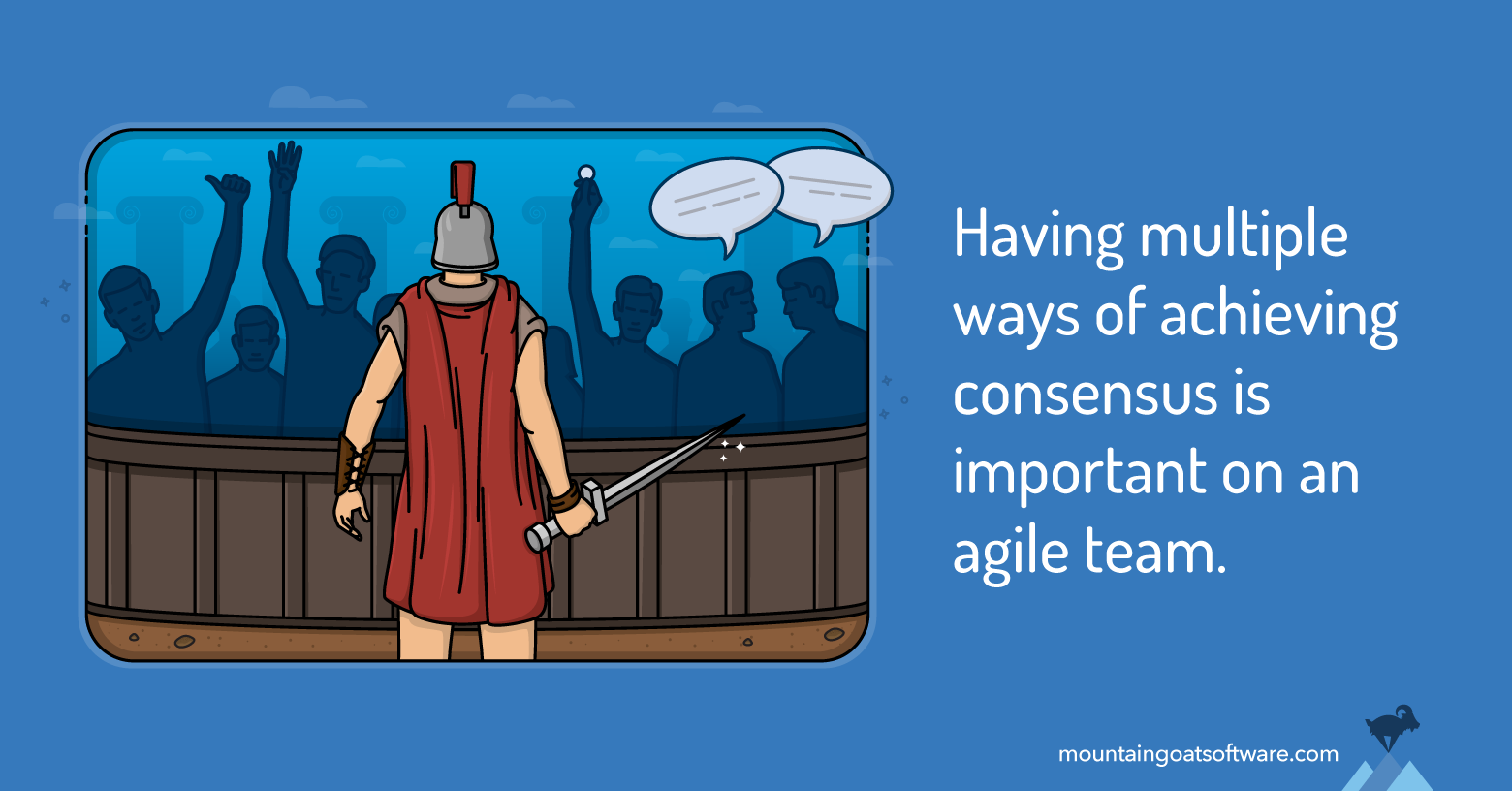In their role as facilitators, Scrum Masters, agile coaches, product owners, and others often need to help teams achieve consensus. This could be a product owner getting a group of stakeholders to agree on a significant objective for the coming period. Or it could be a Scrum Master wrapping up a retrospective and seeking agreement on which improvements team members to want to pursue.
I want to share four consensus-building techniques for these and similar situations. You’re probably familiar with a couple of them but perhaps not with all. After describing each technique, I’ll offer some guidance on choosing between them.
Consensus-Building Approach 1: Dot Voting
Dot voting is a useful approach when a group wants to select multiple options from a larger list. I’ve used dot voting lately in the following situations:
- As part of a team choosing what to improve at the end of a retrospective
- With my family to choose a subset of fun things to do on an upcoming vacation
- As part of an executive team to determine the organization’s top priorities for the coming quarter
Dot Voting in Practice
In dot voting, each person is given some number of votes. Usually each person is given more than one vote but fewer than the total number of options being considered. Dot voting also works if each person is given only one vote, but at that point is nothing more than simply having each person vote for one favorite by a show of hands.
All participants are usually given the same number of votes. This is certainly the most equitable. You could certainly use dot voting and give one person more votes, but I’ve never done that and it’s likely to feel very unfair to others.
After a list of possible options has been generated (usually through brainstorming), each person places their dots next to the item or items they favor. This can be done with colored markers or by buying little sticky dots from an office supply store.
In most uses of dot voting, you’ll want to allow people to place multiple dots next to a highly favored option. For example, in my family’s vacation planning, I really wanted to spend one day on a sailboat. I voted all five of my dots on that. My wife gave it one vote and put her other four dots on two other items.
Waiting to See How Others Vote
In dot voting, some people may hesitate a bit to vote because they want to see how others vote. Perhaps my wife wanted to go sailing as much as I did. But after she saw my five dots on that option, she put four of her dots elsewhere, feeling confident that six total sailing votes would be enough.
In general, don’t worry about this. For every person who stalls to see how the early votes shape up, there will be others who vote instantly, hoping that will influence others.
Alternatively, if you are concerned, have individuals vote privately on paper and then hand you the votes to be tallied.
Choosing the Winners
Because dot voting is most commonly used when a group wants to select multiple options, achieving consensus means identifying a set of winning options. There’s no standard way of doing this.
Before voting, you might say, “We’re going to pick the three [or whatever] top vote-getters.” This works well when you know you need a subset of a certain size. Or you can wait to choose your subset size after voting, which is often better because there’s usually a big drop off in votes between winning and losing options.
When to Use Dot Voting
Dot voting is an excellent approach when multiple courses of action can be chosen. It is also good for revealing overall breadth of consensus. For example, if two items win with three votes but eight other options each have one vote, that indicates a fairly weak consensus. This could be a sign that more discussion is needed, either in that meeting or on an ongoing basis afterwards.
Consensus-Building Approach 2: Roman Voting
Roman voting takes its name from practice of a Roman emperor holding a thumb up or down to indicate whether a gladiator would live or die.
Roman voting is used by teams or other groups in agile organizations when making a single yes/no decision. After discussing the merits of a possible decision, each participant votes. A thumb up is a vote in favor of a decision. A thumb down is a vote against that decision.
Suppose a team wants to go for a group lunch. Someone says, “Let’s go to the burger place next door.” A vote is called for and results in three thumbs up, two down, and one sideways.
Be Careful of the Sideways Thumb
You want to be careful of sideways thumbs. In the restaurant example, this probably means someone doesn’t care: I could eat there or not, but I don’t have a strong preference.
That’s fair in this example. But it’s not in others.
For example, suppose the team is meeting to make a decision about whether to hire a new team member everyone just interviewed. And Caleb holds his thumb sideways.
What does that mean? We can’t half hire the person. A decision like this is binary. We either hire or we don’t.
I share this example because it used to happen to me a lot. A team member would hold a thumb sideways and say something like, “The candidate is good, but we might be able to find a better DBA.”
Uh, sure, I’d think. We never set out to hire the world’s best DBA. We just wanted a great DBA who would also be a fit for this team. What I really need to know is whether this candidate is that person or not.
When to Use Roman Voting
Roman voting is best used when a group needs to choose one option. For example, should we use a particular architecture or technology, should we hire this person, or should we change to three-week sprints.
Consensus-Building Approach 3: Fists of Five
I was first introduced to the fists of five approach to assessing consensus by Jean Tabaka, author of Collaboration Explained This approach is helpful when a facilitator wants to allow and gauge a range of agreement. For example, I might love the idea of going to the hamburger restaurant next door, you might be ok with it, and another team member might hate that place. Fists of Five is more nuanced than approaches like Roman voting.
What the Fingers Mean
In a fists-of-five vote, each team member will hold up the number of fingers that indicates how strongly he or she supports a decision. Various meanings can be given to the different number of fingers, but here’s my favorite:
- Five fingers: This is a great idea. I wish I’d thought of it.
- Four fingers: This is a good idea and has my full support.
- Three fingers: I’m neutral. The idea is OK. Maybe there’s a better idea. Maybe not.
- Two fingers: I don’t like this idea. I’d prefer we do something different.
- One finger: This is a project-threatening decision. We need to pursue an alternative.
Before You Start, Agree on a Level of Agreement
Before even holding a first fist-of-five vote, team members should discuss and agree on how strong their consensus needs to be. For example, an architectural decision would likely warrant greater consensus than which restaurant should cater Friday’s planning meeting.
Let’s look at a couple of sample degrees of consensus.
A team might be tempted to say that all decisions require everyone to hold up at least three fingers. This is a very strong form of consensus. This means no one thinks the idea is even a slightly bad one. I’m not saying you shouldn’t pursue this level of agreement in some cases, but it’s a very strong level of consensus, meaning it will likely take longer to achieve.
Consider instead a team that agrees a decision is good enough as there are more four- and five-finger votes than one- and two-finger votes. This is a much more moderate degree of consensus and would be easier to achieve. But, there might be some significant second-guessing if the decision doesn’t produce perfect results.
Finally, consider a team that decides it will move forward with any decision that doesn’t have any one-finger votes. Blocking a decision with a single one-finger vote is essentially granting veto power to each person.
As with the other examples I’ve given, there may be times when this is appropriate. For example, allowing veto power may be good for deciding where to go for the team lunch on Friday. Everyone but Mary wants to eat at The Hungry Heifer steak restaurant. But Mary holds up one finger because she’s vegetarian and the Hungry Heifer only serves beef.
Mary’s one-finger doesn’t really indicate that this is a project-threatening decision per my definitions above. But a team choosing to eat somewhere one team member absolutely cannot eat is rude and generally a bad decision.
Remember, you can use different degrees of consensus for different decisions. But before voting on a particular issue, have a short discussion over what consensus means for the decision about to be made.
Showing the Fingers
Once participants have agreed on the degree of consensus being pursued, participants discuss the issue, and vote when ready. Normally on a count of three, each participant holds up one to five fingers. (If one finger, be sure it’s not the wrong finger!)
Assess the results and if consensus is achieved, you’re done. If not, participants discuss and vote again. Participants can agree to lower the degree of consensus being sought if necessary.
When to Use Fists of Five
Fists of Five is good for both gauging a degree of consensus and voting to make a decision. Like Roman voting, it should be used when selecting one option among many rather than when choosing multiple options.
Consensus Building Approach 4: 1-2-4-All
The 1-2-4-All approach is more of a technique for building consensus than for voting. In fact, this approach may frequently end with a vote using one of the other three techniques.
The approach draws its name from the number of people involved in each of a series of conversations. It starts with each person spending a few minutes (2-5 is usually quite sufficient) making up their own mind about a decision.
Pairing the Pairs and Beyond
Individuals then pair up. Each shares their own opinion and the pairs try to gain agreement. How pairs are formed is completely up to you. You could form specific pairs by assignment or simply by whoever is adjacent to one another in a meeting.
If an odd number of people are present, the facilitator can sit the discussion out, especially if a truly impartial facilitator. Alternatively the facilitator can be part of a pair but act more in a listener-only mode to help the other person prepare arguments in favor of a position.
Pairs are normally given 5-10 minutes for their discussion. Although this can vary based on the criticality of the decision being made, I don’t recommend going much beyond 15 minutes.
After all pairs agree or the agreed upon time limit has been reached, pairs of pairs are formed. This is the “4” of the approach’s name. It’s quite possible you’ll have groups of different size at this point. That’s fine, adjust group sizes as seems best. These group are given 10 to 15 minutes to try to gain consensus among themselves.
After all groups have reached consensus or after the timebox expires, the groups of four are merged. For a typical agile team, this will usually be the whole team. If not, allow progressively larger groups to talk until the whole team is in one group.
With the whole group together, encourage the full group to come to agreement. It doesn’t always happen, but the 1-2-4 discussions often help make the full-group discussion easier. If appropriate, use dot voting, Roman voting, or fists of five to make the final decision.
When to use 1-2-4-All
The 1-2-4-All approach is best used on important decisions and when a team is nowhere near consensus. The increasingly large discussion groups ensure each person has a chance to be heard but also includes time at the start for individual thought.
Choosing an Approach to Gaining Consensus
Each of the approaches I’ve described has its own strengths and weaknesses. A good agile facilitator will use each at different times. No single approach is right for all decisions and all teams.
- If you want to select multiple options from a larger set of options: Use dot voting.
- If making a decision is important but it’s more important that everyone deeply understand and buy into a decision, use the 1-2-4-All approach possibly followed by one of the three voting approaches.
- If you want to select a single option and a simple yes/no decision is good enough, use Roman Voting.
- If you want to select a single option and need a more nuanced consensus, use fists of five.
To help choose the right approach, you may want to use the following diagram, which generalizes a decision-making process. Always use your own judgment based on the criticality of the issue, significance of disagreement, and more.
Last update: June 25th, 2024









